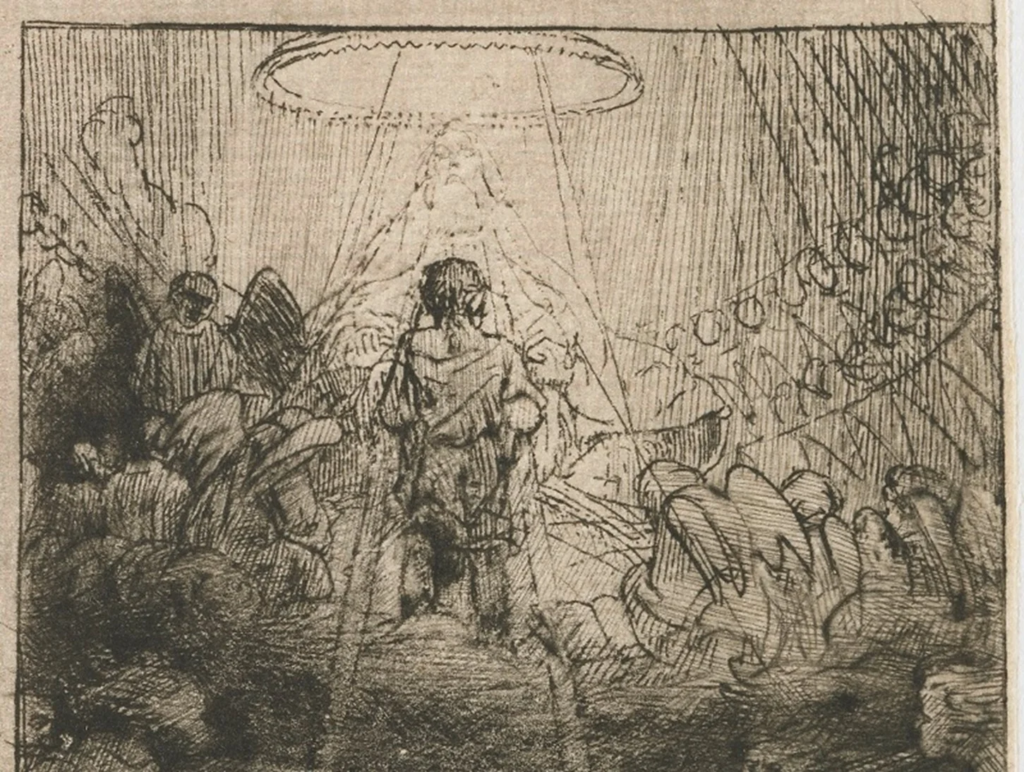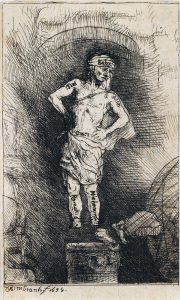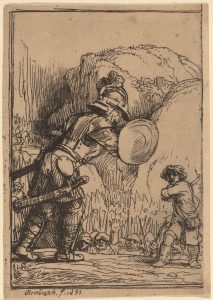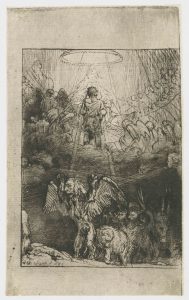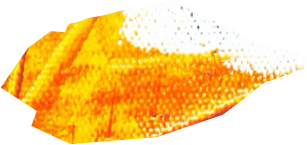Scholars have long puzzled over the etchings by Rembrandt that appear in some extant copies of Piedra Gloriosa, a messianic treatise by Menasseh ben Israel published in Amsterdam in 1655. Do the illustrations represent a true collaboration between the artist and the rabbi? Why do the illustrations appear in only some of the extant volumes? Perhaps the most perplexing question of all is why do a few of the extant copies contain illustrations that representationally (if not aesthetically) fairly duplicate those by Rembrandt but by a different artist and with at least one very significant modification?
In this article, though we briefly address the first question and review the current state of scholarly opinion, we are concerned primarily with second and third questions. How can we account for the fact that most extant volumes contain no illustrations at all; and what might explain the substitution of a new set of illustrations for those by Rembrandt? We show that a recently uncovered document in the record book of the Amsterdam Portuguese-Jewish community sheds some new light on these matters and may point toward a plausible explanation for the switch.
Menasseh and Rembrandt
Menasseh ben Israel (Lisbon 1604 – Middelburg 1657) was among the rabbis of the three Portuguese-Jewish congregations that existed in Amsterdam in the early decades of the seventeenth century. When these congregations merged to form the Talmud Torah congregation in 1639, Menasseh was appointed third in rank of the four rabbis. He was also a prolific author and printer of Judaica, and arguably the most famous Jew in Europe in the period. Gentile scholars from all over the Continent consulted him on Jewish theological and philosophical topics.
It is a commonplace in the literature to claim that Rembrandt and Menasseh were not just neighbors, but friends and collaborators.1 Menasseh was certainly not, as some have asserted, Rembrandt’s “neighbor on the Breestraat” or living “in a house across the street.”2 However, the two men did live in the same neighborhood and not very far from each other. While Rembrandt was living on the Breestraat from 1632 to 1635, and then again—after brief residencies on the Doelenstraat between 1635 to 1637 and in the “Suikerbakkerij” on the Binnen-Amstel between 1637 to 1639—from 1639 to around 1658, Menasseh resided in (and ran his printing business from) a house on the “Nieuwe Houtmarkt,” a vague designation for somewhere on the Vlooienburg island, which was just across the Houtgracht from the Breestraat. This was not a very large quarter of the city, and thus it easy to believe that such prominent individuals as Rembrandt and Menasseh knew each other (or at least knew of each other); no doubt they occasionally passed one another on the street. They also had some mutual acquaintances, including several members of the city’s Portuguese-Jewish community. There is, for example, the physician Ephraim Bueno, who sat for a small oil portrait by Rembrandt3 that served as the modello for the etched portrait of Bueno that he also made (dated 1647); the wealthy Dr. Bueno was also a financial backer of Menasseh’s printing business.
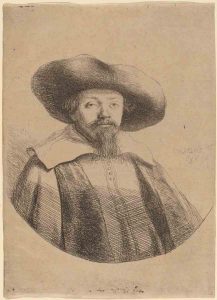
One item typically offered as a reason for thinking there was more than just a passing familiarity between the artist and the rabbi is an etching that Rembrandt made in 1636, the one that appears in Edmé-François Gersaint’s 1751 catalogue raisonné with the label “Le portrait du Juif Manassé, Ben-Israel” (fig. 1).4 Scholars have been insisting for some time that this is not a portrait of Menasseh ben Israel. To be sure, there is nothing in the etching itself to indicate that it is a portrait of a rabbi or even a Jew, much less of Menasseh. The identification comes relatively late, first appearing in print with Gersaint himself, who was followed uncritically by later cataloguers.5 Nonetheless, at least one recent authoritative study is more inclined to accept the Menasseh identification, “not in the least because Gersaint has proven to be a reliable chroniquer”6 , although the same author elsewhere grants that “the basis for the identification is perhaps shaky and doubt may well be justified.”7 Thus, the jury is still out on this one.
More intriguing is an element in Rembrandt’s painting “Belshazzar’s Feast” (mid-1630s), for which Menasseh is, on highly plausible grounds, often said to have provided guidance (fig. 2).8
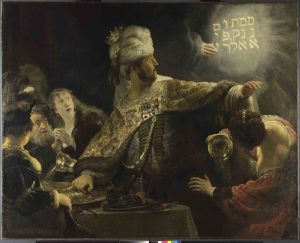
In the Biblical episode from the Book of Daniel (5:1–30), Belshazzar is giving a banquet using the vessels of gold and silver that his father, Nebuchadnezzar, had taken from the Temple sanctuary in Jerusalem when all of a sudden a very strange vision emerges: a hand writing something on the palace wall behind the king. Everyone is puzzled by the apparition, and the Israelite exile Daniel is the only member of the court who can read the message and provide an interpretation. The Aramaic text, he tells the king, says “Mene, mene, tekel, ufarsin”: a list of declining units of measure that means, essentially, “Your days are numbered.”
In Rembrandt’s painting, a surprised Belshazzar turns around as a hand emerges from a cloud and writes the message in Hebraic characters. The biblical text does not say why none of the king’s guests or ministers could read the words, nor does it give any indication as to the form in which the message was written. This gave rise to some debate among the ancient rabbis as to how the writing must have looked to the confused banqueters. Were the words encrypted in some way? Were they written backward, from left to right? Were letters transposed? Or were the words to be read right to left but vertically downward rather than horizontally across?9
This last, vertical format of the mysterious text is exactly how it is depicted in Rembrandt’s painting. It is also the only one of the rabbinic explanations that is presented by Menasseh in his discussion of the Belshazzar episode in his book De Termino Vitae (1639), where he includes a diagram of the words that resembles perfectly the image in Rembrandt’s painting (fig. 3).10 It thus seems very likely that Rembrandt, wondering just how he should depict the divine message in his painting of a scene from Hebrew Scripture, and perhaps at the recommendation of some acquaintance in the Portuguese-Jewish community, walked down the street and over the Houtgracht bridge to consult with the extroverted rabbi known for his ecumenical, and often very friendly, relationships with non-Jews.
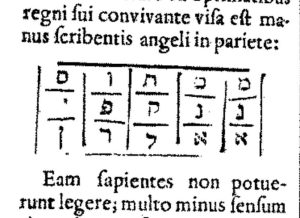
Menasseh’s book was published in 1639, and depending on the dating of the painting this could be several years after Rembrandt had finished the work.11 But the theory about the format of the divine writing would have been on Menasseh’s mind for a while, and he certainly could have helped Rembrandt with this in person, before writing his book. The idea that Menasseh did advise Rembrandt on “Belshazzar’s Feast” is thus fairly compelling, and represents at least one, albeit probably brief, instance of collaboration.12
Piedra Gloriosa / The Glorious Stone
The project that is most often cited as proof of a working partnership between artist and rabbi, and the one that concerns us here, is Menasseh’s book Piedra Gloriosa (full title: Even yekarah. Piedra Gloriosa o de la Estatua de Nebuchadnesar [The Glorious Stone, or On the Statue of Nebuchadnezzar]), a messianic treatise that Menasseh published in 1655, a few months before his departure for England to negotiate the readmission of the Jews to a kingdom from which they had been formally banned since 1290, and just two years before his death.
Much of Menasseh’s treatise is a commentary on the Book of Daniel, which, like the story of Esther, was of great importance in the early modern period to both Jews in the Sephardic diaspora and Judaizing conversos still living in Spain and Portugal. Among other things, Menasseh offers an interpretation of the episode from Daniel in which Nebuchadnezzar, the King of Babylon, dreams of a “huge and dazzling” statue—with a head of gold, breast and arms of silver, torso of bronze, legs of iron, and feet of clay and iron—that is then toppled and shattered by a boulder (Daniel 2:31–36). In the Biblical story, Daniel explains the king’s dream as forecasting the doom facing his and subsequent kingdoms. Daniel then foretells of “a kingdom established by the God of heaven that will never be destroyed … it shall shatter and make an end to all those kingdoms, it shall itself endure forever.”
It was not very difficult for Menasseh to find messianic import in Daniel’s dream interpretation. The stone that crushes the king’s statue, “hewn from a mountain without the intervention of human hands”, represents the Messiah sent by God. Having swept away all other empires of the world—the Babylonians, the Persians, the Greeks and the Romans, represented by the materially composite statue—God will replace them with the Kingdom of Israel. “This stone is the Messiah, a stone that, striking the feet of the statue, will put an end to all the kingdoms of the Fourth Monarchy, will become an immense mountain and will fill the world.”13
Not content to provide a reading of these passages from Daniel, Menasseh argues that the same messianic message is present throughout the Hebrew Bible. It is there in the Pentateuch’s narratives of the patriarchs, as well as in the writings of the prophets. It is certain, he says, that “God revealed to [Moses] the entire history of the Jews up to the end of time”14 , and so the Torah is full of indications about the fate of the Four Monarchies and the establishment of the Fifth. Indeed, Menasseh says, “there is no prophet to whom God has not revealed this mystery.”15
Remarkably, Menasseh goes on to claim that the stone that topples the statue in Nebuchadnezzar’s dream is in fact identical with stones that appear in two other well-known Biblical stories. It is the same exact rock as that on which Jacob’s head rests while he dreams about angels going up and down a ladder and which he then sets up as a sacred pillar onto which he pours oil (Genesis 28:10-19). “We have here the same stone,” Menasseh insists, “the stone of the Messiah.”16 Then there is the stone with which David, representing the Messiah, slays the Philistine giant Goliath, who stands for both the statue of Nebuchadnezzar and the four captivities of Israel (I Samuel 17). David, Menasseh notes, had five stones in his bag. Four of them are “useless,” and represent the Four Monarchies. “The fifth one stands for the one that shattered the Statue. It is the same stone on which Jacob poured oil, and the same one of which Daniel spoke.”17
The finale of the treatise is Menasseh’s extended discussion of Daniel’s vision of the beasts (7:1-27). Daniel relates that during the reign of Belshazzar, “I saw a great sea churned up by the four winds of heaven, and four huge beasts coming up out of the sea.” One was a lion with eagle’s wings; a second was a bear; and a third was a four-headed leopard with four bird wings on its back. Most terrifying of all was a fourth beast, “dreadful and grisly, exceedingly strong, with great iron teeth and bronze claws. It crunched and devoured, and then trampled underfoot all that was left. It differed from all the beasts that preceded it in having ten horns.” One of the horns had “eyes like the eyes of a man and a mouth that spoke proud words.” This last beast was killed and its carcass thrown into flames. Then, Daniel, continues,
“I saw one like a man coming with the clouds of heaven; he approached the Ancient in Years and was presented to him. Sovereignty and glory and kingly power were given to him so that all people and nations of every language should serve him; his sovereignty was to be an everlasting sovereignty which should not pass away, and his kingly power such as should never be impaired.”
On Menasseh’s reading, the four beasts are, once again, the four doomed kingdoms, while the man coming down from heaven is the Messiah. His fifth kingdom will be an everlasting worldly dominion.18 “The monarchy of Israel”, Menasseh insists, “will be temporal and terrestrial”, with the Davidic king sent by God ruling all nations under one law.
A Collaboration?
Menasseh was ready to publish his Spanish book in early 1655. However, he thought it should contain some illustrations. His interpretive analyses of the toppling of Nebuchadnezzar’s statue, Jacob dreaming of the ladder, David felling Goliath, and especially Daniel’s graphic vision of the beasts all needed visual aids. Menasseh relates that he was responsible for four images of just these episodes for the book. Here is what he says in the preface Al Lector / To the Reader:
Iuntamente par mayor claridad de lo que se dize, he hecho en laminas, con grande propriedad, 4. figuras (Additionally, for better clarity of what is said, I have done [made] 4 figures [images] on plates, with great propriety [accuracy?]).
He then describes the four illustrated scenes in detail, adding that “Todo esto ha costado, y aun algun trabajo y industria (All of this was costly, and [required] even some work and industry).”19
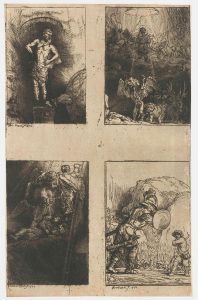
Now a number of extant copies of the Piedra Gloriosa do (or apparently at one time did) contain such illustrations, but—contrary to what one might expect from what Menasseh says in the preface—they are not by Menasseh himself.20 Rather, as we have mentioned, and is well known, they are by Rembrandt (figs. 4-7).21 Many commentators have taken this as evidence that there was a direct and personal collaboration between the rabbi and the artist on the book.22 Thus, in the mid-twentieth century, Franz Landsberger, in his book-length essay Rembrandt, the Jews and the Bible, says of the relationship between Menasseh and Rembrandt that “we know only that Rembrandt made a portrait and etching of the distinguished rabbi, and that he furnished illustrations for one of the latter’s books; these illustrations, however, seem never to have been published.”23 The first claim about what “we know” is, as we have seen, uncertain; the second claim is true, in a sense to be examined; and the truth value of the third claim depends on what is meant by “published.” More recently, Christian Tümpel says simply that “in the mid-1650s, Menasseh asked his neighbor in the Breestraat for four illustrations for his book Piedra Gloriosa.”24
Other scholars have questioned whether, and even denied that, Rembrandt produced these images for Menasseh’s book at the author’s request. They cite, in addition to the lack of any documentation of a collaboration or mention of it by either party, the unsuitability of etchings to illustrate books that have more than a very limited print run.25 It is possible, though, that the etchings were meant to be printed in only a limited number—for example, to be included in just a few gift presentation copies of the book “for friends and people who, like Isaac Vossius [to whom the book is dedicated], had been involved in the book in a special way.”26
So one question is: Was there a collaboration between Rembrandt and Menasseh ben Israel on the book Piedra Gloriosa? More precisely, did Menasseh commission from Rembrandt the four etchings that appear in some copies of the book?
Despite skepticism by some scholars, it seems extremely likely that there was indeed a collaboration here.27 When Menasseh says, in his preface, that “I have done [made] 4 figures [images] on plates”, he might seem to be claiming that he himself made etched illustrations for the book. But no prints by his hand appear in any copy or, as far as we know, are extant in any other format. Nor could he, without serious technical training, have produced multiple states of etched plates of sufficiently high artistic quality.28 The more likely reading of the sentence, then, is not that Menasseh made etched plates of four images, but that he had some etched plates made according to his vision of what the illustrations should look like, “for better clarity of what is said.” That is, Menasseh was responsible for designing, and perhaps even sketching out, what the illustrations should be, just as he describes them in the preface. He then passed all this along to an illustrator, who then executed the designs in etchings, perhaps with Menasseh’s input through each state of the etchings.29 That the artist to whom Menasseh gave his designs was Rembrandt seems the perfectly natural conclusion to draw from the facts that (a) Menasseh says he designed and commissioned some illustrations, and (b) the illustrations that appear in some copies of the book (closely matching the description of the illustrations that Menasseh provides) are by Rembrandt.
One of the arguments that has been offered against Menasseh being the subject of that 1636 etched portrait is that he could not have afforded it given his weak financial condition.30 Perhaps similar considerations, then, might seem to tell against Menasseh commissioning book illustrations from Rembrandt. It is true that Menasseh suffered from debts and life-long money problems.31 Part of the problem was that, while he was third in rank among the Talmud Torah rabbis, he had by far the lowest salary—only 150 guilders per year (whereas the chief rabbi, Saul Levi Mortera, was earning 600 guilders per year, while the rabbi second in rank, Isaac Aboab da Fonseca, was earning 450 guilders).
However, in 1654, Menasseh was awarded a substantial annual stipend, 600 guilders, in order to dissuade him from going to England.32 This extra income could have allowed him to afford what Rembrandt might have demanded for the commission. Of course, we do not know what Rembrandt asked in order to do the job. The same year that Menasseh published Piedra Gloriosa, Rembrandt was commissioned to produce “a portrait of Otto van Kattenburch which the aforementioned van Rijn shall etch from life, equal in quality to his portrait of Mr. Jan Six, for the sum of 400:0:00.”33 Six was a wealthy member of the Amsterdam city council, and Rembrandt’s 1647 etching of him (240 x 193 mm) was about the same size as the uncut plate for the Piedra Gloriosa prints (280 x 160 mm). Thus, if the Kattenburch etching was to be similar in dimensions to the Six etching (and, by extension, to the Piedra Gloriosa plate) and its cost was 400 fl, one can surmise that, under ordinary circumstances, Rembrandt might have asked for something in that range from Menasseh. On the other hand, a flattering portrait of a wealthy individual would have been priced quite a bit higher than a creative history scene (or set of scenes), especially for a rabbi of limited means. Moreover, as one scholar notes, “the valuation of 400 guilders for a portrait plate was exceptional.” 34 Whatever Rembrandt asked, if anything, would still have been an extraordinary expense for someone who always struggled financially, even with the new stipend. But perhaps Menasseh saw it as an investment in his own book and expected to recoup the initial outlay through sales. Another likely possibility is that Rembrandt did the work out of vriendendienst, as a favor for a friend.35 Or maybe he produced the etchings on speculation, expecting to take his cut from sales of the book with the illustrations.36
How did the collaboration come about? The most plausible scenario, which we described above, is that Menasseh directly enlisted Rembrandt’s participation in this project, especially if there was a “history” between the two, namely, the previous collaboration on the “Belshazzar” painting. Even if, as some have suggested, there was no such earlier working relationship37 , then perhaps Menasseh, never shy about engaging gentiles in social and professional matters, simply approached one of the city’s most celebrated artists and gifted etchers who also happened to live nearby and asked him to lend his talents to a new book.
Another possibility is that Rembrandt and Menasseh were brought together by a third party, one of several people who knew both of them. After all, their respective circles of acquaintances did overlap. One candidate is Ephraim Bueno. Another candidate is Gerbrand Anslo, a Mennonite cloth merchant who had studied Hebrew and rabbinics with Menasseh. Anslo and Menasseh apparently enjoyed a warm, interfaith friendship. They passed the time together in each other’s home; Anslo wrote a laudatory poem about Menasseh (whom he calls “most learned of the rabbis”) for Menasseh’s treatise De Resurrectione mortuorum/On The Resurrection of the Dead (1636); and Menasseh dedicated the Latin edition of his book on free will and human sin, Dissertatio de fragilitate humana/Dissertation on Human Fragility (1642), to Anslo.38 Anslo’s father Cornelis Claesz Anslo had sat for two portraits by Rembrandt—a painted double-portrait with his wife (1641)39 , and a solo etched portrait40—and Gerbrand was a good friend of fellow Mennonite Hendrick Uylenburgh, Rembrandt’s erstwhile employer and cousin in-law.41
Yet another possible candidate, close to Menasseh but somewhat removed from Rembrandt, is the book’s dedicatee, Isaac Vossius. Menasseh’s dedication reads “To the very noble and most learned lord, Isaac Vossius, gentleman of the chamber of the Queen of Sweden.” Vossius, the son of Menasseh’s good friend, the humanist scholar Gerard Vossius, was still serving as librarian to Queen Christina, despite the fact that she had abdicated the throne in June 1654 after converting to Catholicism. From Christina’s new home base in exile in the southern Netherlands, Vossius, through correspondence and occasional trips to Amsterdam, was in regular contact with Menasseh over the purchase of books for her library. As far as we know, Vossius was not among Rembrandt’s acquaintances. However, he was connected with some of Rembrandt’s patrons and sitters, including Six. Six was not only the subject of the etching mentioned above, but he also sat for his extraordinary portrait by Rembrandt in 1654, just before Menasseh completed the Piedra Gloriosa. Vossius and Six were, by Vossius’s own testimony, close friends. In one of his letters, Vossius good-naturedly complains about the way that Six’s bidding at book auctions drives the prices up, “so unprofitable was his friendship to me. Still”, he says, “we are friends and will be forever.”42 So perhaps Vossius, on behalf of Menasseh, prompted Jan Six to ask Rembrandt if he would produce some illustrations for the new book by Vossius’s rabbi friend.43
The problem with this story, however, is that Vossius did not share his father’s high opinion either of Menasseh’s books or of the rabbi himself. He reportedly regarded Menasseh’s messianic views as “ludicrous speculations.”44 As a conversionist, he counseled the Jews to abandon their own false messianic hopes and embrace “the kingdom of God and Christ.”45 It seems unlikely, then, that he would have gone to the trouble to help Menasseh find someone to illustrate those vain hopes.
Of course, an alternative explanation for the presence of the Rembrandt etchings in Piedra Gloriosa—one that might account for the fact that they are in only a few of the extant copies—is that they were commissioned not by Menasseh himself for a complete or partial print run, but by someone else, who then inserted them into copies that he or she had purchased. This hypothesis, however, is very difficult to square with the fact that Menasseh himself tells us about the four illustrations in the book. Not only do we have his remarks in the preface, which describe precisely what appears in Rembrandt’s etchings, but in several places throughout the book he refers to the images or picture “we have made” (read: “we have had made”).46 It would be very odd to find Menasseh doing this in a book for which illustrations would be commissioned and inserted only by someone else subsequent to the book’s publication.
A Mystery and a Solution
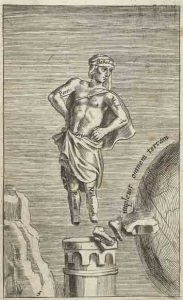
Even if we accept that Menasseh and Rembrandt collaborated on Menasseh’s messianic volume, many questions remain. The one we want to address is this: Why is it that Rembrandt’s etchings appear (or apparently once appeared) in only nine of the known twenty-three extant volumes, with ten of those books lacking any illustrations whatsoever? Adding to the mystery is the fact that at least four extant copies of the book have copperplate engravings by another artist (figs. 8 and 9). (The artist responsible for these has often been assumed to be a Jewish artist from Italy now living in Amsterdam, Salom Italia47 ; this is now a contested claim, with good reason, and so we will refer to the author of the second set of prints as “Salom Italia.”48 ) These “new” images—on the plausible assumption that Rembrandt’s etchings came first and that the engravings were indeed intended as a substitute for them—are very similar in depicted content to Rembrandt’s illustrations (aside from their inferior artistic quality), with one remarkable difference. In Rembrandt’s etched illustration of Daniel’s vision, there is a clearly anthropomorphic representation of God as an old, bearded man in robes sitting in the heavens; in the “Italia” engravings, by contrast, the bodily depiction of God is replaced by an illuminated empty space above the heavenly choir.
This, naturally, has given rise to new domains of speculation. Are the “Italia” engravings, which are mostly (but not entirely) consistent with Menasseh’s description of the illustrations in his preface, original to those volumes in which they appear? Or did these volumes initially include Rembrandt’s etchings, which were removed before binding? The really interesting question, of course, is this: Why the substitution in the first place? Was Menasseh unhappy with
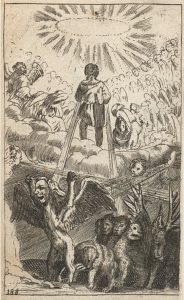
Rembrandt’s etchings, especially the anthropomorphic representation of God sitting on His throne, and thus did he commission a less offensive set of pictures, as some have argued?49
This explanation seems unlikely to us. If Menasseh did not approve of the representation of God, then why does this etching appear among the Rembrandt illustrations in those other copies of the book? On the assumption that it was Menasseh who commissioned the prints, and assuming as well that client and artist were working together throughout the process, then Menasseh would have had plenty of opportunity to protest the appearance of God through all four states of that etching.50 In fact, in his preface, Menasseh describes this illlustration right down to the bodily detail of God’s hand. He says that
Finalmente en la quarta, las 4 bestias, y entre ellas aquel javali con diez cuernos, y otro pequeño con boca y ojos: levantando las nuves a aquel que como hijo de hombre que es el Messiah, se presenta a la Soberana Magestad, para recebir de su mano poderosa el imperio universal del mondo.
Finally, in the fourth [illustration], the four beasts, and among them that boar with ten horns, and another one small with mouth and eyes: the clouds raising that [person] who, as son of man who is the Messiah, presents himself to the Sovereign Majesty [that is, to God] to receive from his powerful hand the universal empire of the world.51
Referring to this scene later in the book, Menasseh once again describes the details of the illustration:
… presentando delante la divina Magestad, y su Altissimo Trono, dará de su propria mano, el imperio universal del mundo.
… presenting [the Messiah] in front of the divine Majesty, and his Highest Throne, [God] will give from his own hand, the universal empire of the world.52
There is no hint of any scruples here. The idea that Menasseh did not approve of the corporeal depiction of an anthropomorphic God literally sitting on a throne is therefore rather implausible.53 Thus, the mystery persists, or so it would seem.
However, there is a document, hiding in plain sight in an archival volume that scholars have long known and consulted, that provides the foundation for a more plausible explanation than any other hypotheses for (a) the switch from Rembrandt’s etchings to another artist’s renderings, and/or (b) the absence of illustrations in most extant copies of a book whose text refers, in detail in several places, to illustrations. In the first volume of the Livro dos Acordos da Naçao (the general record book of the Portuguese-Jewish community of Amsterdam, now in the Amsterdam Municipal Archives), which covers the years 1638—just before the merger into Talmud Torah—through 1680 (5398-5440), there is a memo dated 29 Nisan 5415 (6 May 1655).54 The document reads as follows (in a rough English translation55 ):
“On Nisan 29, the members of the Ma’amad being gathered together, the rabbi haham Menasseh ben Israel presented himself in front of them, requesting a book that he composed about the interpretation of Nebuchadnezzar’s dream, which he [Menasseh] had given to be reviewed after printing. And the members of the Ma’amad, having disapproved of it for it was against the ascamot [regulations], the said rabbi responded to the members of the Ma’amad and swore by the Holy God to not print another one [copy? edition?] without first bringing its principal [i.e., its content?] [before?] the aforementioned members of the Ma’amad: and ratifying his oath, he [Menasseh] left the chamber of the Ma’amad. There were present all the seven that made this decree, so that it may be registered for all time.56“
At the bottom of the document are the signatures of the seven men sitting on the community’s ma’amad (board of lay directors) that year.
This document raises many more questions than it answers. Among these, and relevant to our discussion, are the following: What did the ma’amad actually have in hand when they passed judgment on Piedra Gloriosa? Had Menasseh already printed a full run of the edition and was he only now asking for the congregation’s approval after the fact? Or did he present the leaders with only a set of pre-publication proofs? It was clearly not only a manuscript that they saw, since the censorship record mentions that Menasseh brought them “a book … after being printed”, but this could refer either to a single exemplar of the work’s pages to be approved before printing a full run, or it could mean a copy from a full print run; either of these would likely have consisted solely in unbound sheets. More important for our purpose, did whatever Menasseh present to the ma’amad for approval contain Rembrandt’s illustrations?
That Menasseh’s messianist book was “disapproved of [Reprovado]” by the Amsterdam ma’amad has previously gone unrecognized (despite the fact that scholars of the history of the city’s Portuguese-Jewish community have long been examining the Livro dos Acordos). To be sure, Menasseh could be a difficult person, and his relationship with the communal leadership and the other rabbis was often rocky. He even earned a herem (a ban or ostracism) at one point for his insubordination.57 Nor was this the first time that the ma’amad disapproved of what was coming off Menasseh’s printing press; they let him know in no uncertain terms that they were not pleased when, in 1628, soon after establishing his business, he published Joseph Solomon Delmedigo’s Sefer Elim, and they initially refused him permission to publish it.58 However, the fact that they also initially forbade him to publish the Piedra Gloriosa—and perhaps, for all we know, never granted permission at all—is only now evident from this entry in the Livro dos Acordos.59
Because the book was deemed “against the regulations”, Menasseh was told not to print another copy. While the censure document does not specify what exactly the parnassim (directors) on the board found offensive about the book, it may very likely be that the problem for them at least, if not for Menasseh, was Rembrandt’s etchings—in particular, the representation of God in bodily, anthropomorphic form. As far as we can determine, there are no differences whatsoever in the text itself among the various extant copies—both those that contain Rembrandt’s etchings and those that contain the “Italia” engravings or no illustrations at all—and so no changes were made in that regard. (It should be noted, too, that, contrary to what some scholars have asserted, the “Salom Italia” illustrations were not prepared for a new edition of the book, since there was no second edition or even second printing.60 )
There are, on the other hand, clear differences between the “Italia” illustrations and Rembrandt’s. Most of these differences are merely aesthetic or relatively insignificant from a substantive perspective, and thus are unlikely to be changes related to anything in Rembrandt’s illustrations having raised alarm. For example, in the illustration of Nebuchadnezzar’s dream, Rembrandt’s statue stands before a rocky grotto, while the “Italia” statue is on a bare background of horizontal lines and there is a Latin motto (impleuit omnem terram, “he filled the whole earth”) along the boulder coming in from the right; in the David and Goliath scene, the orientation is reversed and there is a more mountainous background with a more clearly delineated mounted cavalry lurking there (fig. 10). None of these changes are as remarkable or as significant as the absence of God in the “Italia” representation of Daniel’s vision.
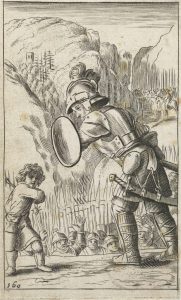
Thus, there seems to be good reason to think that the commission of the “Salom Italia” engravings and their substitution for the Rembrandt etchings in some copies and/or the preparation of copies without any illustrations at all was not due to Menasseh’s own displeasure over the depiction of God. Rather, it was Menasseh’s response to the ma’amad’s objections to that feature and the resulting censorship from within the Amsterdam Portuguese-Jewish community.61
About the authors
Steven Nadler is Vilas Research Professor and William H. Hay II Professor of Philosophy at the University of Wisconsin-Madison, where he is also affiliate faculty in the Department of Art History and the Mosse/Weinstein Center for Jewish Studies, and director of the Institute for Research in the Humanities. His most recent book is Think Least of Death: Spinoza on How to Live and How to Die (Princeton, 2020).
Victor Tiribás is a PhD candidate in History at the Scuola Normale Superiore di Pisa.
- Writing in 1915, Frits Lugt refers to Menasseh as Rembrandt’s “intimate and highly esteemed friend [intieme en hooggeschatte vriend]” (Wandelingen met Rembrandt in en om Amsterdam, Amsterdam 1915, p. 87). More recently, Christian Tümpel claims that Rembrandt and Menasseh “formed a friendship that lasted more than two decades” (Rembrandt: Images and Metaphors, London 2006, p. 109), while Simon Schama says that “the relationship with Menasseh was real and it was serious” (Rembrandt’s Eyes, New York 1999, p. 607). This is, in fact, a very common view. Henri van de Waal, for example, describes “a firm and lasting relationship between the artist who showed such an interest in the Jews and the ‘apostle to the Gentiles’ [i.e., Menasseh]” (“Rembrandt’s Radierungen zur Piedra Gloriosa des Menasseh ben Israel”, Imprimatur: Jahrbuch für Bücherfreunde 12 (1954–1955), pp. 52-61). For biographies of Menasseh, see Cecil Roth, A Life of Menasseh ben Israel: Rabbi, Printer, and Diplomat, 2nd ed., Philadelphia 1945; Lionel Ifrah, L’Aigle d’Amsterdam: Menasseh ben Israel (1604-1657), Paris 2001; Adri Offenberg, “Menasseh ben Israel (1604-1657): A Biographical Sketch”, Menasseh ben Israel Instituut Studies 6 (2011); and Steven Nadler, Menasseh ben Israel: Rabbi of Amsterdam, New Haven 2018.
- See Roth, A Life (see note 1), p. 169; Gary Schwartz, Rembrandt. His Life, His Paintings, New York 1985, p. 175; Reiner Hausherr, “Zur Menetekel-Inschrift auf Rembrandts Belsazarbild”, Oud Holland 78 (1963), pp. 142–49; and Schama, Rembrandt’s Eyes (see note 1), p. 418.
- Oil on panel, 19 x 15 cm, Rijksmuseum, Amsterdam (SK-A-3982).
- Edmé-François Gersaint, Catalogue raisonné de toutes les pièces qui forment l’oeuvre de Rembrandt, Paris 1751, p. 195.
- Jasper Hillegers says that “Gersaint, it emerges, based his conclusion specifically on existing information about Rembrandt’s oeuvre”; see “A Painter Goes to the Rabbi: Rembrandt and Menasseh ben Israel”, in Epco Runia and David DeWitt, eds., Rembrandt’s Social Network: Family, Friends and Acquaintances, exhibition catalog from the Museum Het Rembrandthuis, Amsterdam 2018, pp. 113–117 (p. 115). And Stephanie Dickey notes that Gersaint visited Amsterdam in 1702, which could have been the occasion for him to pick up anecdotal information about Rembrandt and his sitters; see “A Network in Line: Rembrandt’s Portrait Etchings”, in Runia and De Witt, Rembrandt’s Social Network, Amsterdam, 2019, pp. 53–59 (p. 55n5). For an assessment of Gersaint’s reasoning, see S.A.C. Dudok van Heel, “Rembrandt en Menasseh ben Israel”, Kroniek van het Rembrandthuis 93 (1994), pp. 22–29; Dudok van Heel rejects the Menasseh identification. Adri Offenberg argues that it is “highly unlikely” that Menasseh would have commissioned a portrait etching from Rembrandt in 1636, given his “dire financial straits” (“Nogmaals Rembrandt en de rabbijn—rabbijn?”, Vrij Nederland, 15 August 1992, p. 6). Gary Schwartz finds it inconceivable that Rembrandt would not have given a book to a sitter who was not only a scholar and a rabbi but a publisher/printer (The Rembrandt Book, New York 2006, p. 302). For the literature on the debate, see Erik Hinterding, Rembrandt Etchings from the Frits Lugt Collection, 2 vols., Bussum and Paris 2008, vol. 1, pp. 473–475.
- Erik Hinterding and Jaco Rutgers, Rembrandt, 7 vols., The New Hollstein Dutch and Flemish Etchings, Engravings and Woodcuts, 1450-1700, Ouderkerk aan den Ijssel and Amsterdam 2013, vol. 2, p. 3. Hinterding and Rutgers say that “the traditional identification seems not less speculative than the more recently proposed ones”; but we believe that what they mean is that the traditional identification as Menasseh is not more speculative than alternative ones. Of course, if all the identifications are equally speculative, then there is no warrant for claiming that one is more probable than another.
- Hinterding, Rembrandt Etchings (see note 5), vol. 1, p. 474.
- Oil on canvas, 167.6 x 209.2 cm., National Gallery, London. The suggestion of a Rembrandt–Menasseh collaboration on this painting was first made by Johannes Dyserinck, “Eene Hebreeuwsche inscriptie op eene schilderij van Rembrandt”, De Nederlandsche Spectator 49 (1904), pp. 160–61. The argument was expanded by Reiner Hausherr, “Zur Menetekel-Inschrift” (see note 2); and the thesis has since become a commonplace in the literature.
- See Babylonian Talmud, Tractate Sanhedrin, 22a; Midrash Rabbah, Song of Songs, III.4.ii.
- Menasseh ben Israel, De Termino Vitae, Amsterdam 1639, p. 160.
- The dating by art historians ranges from 1635 to 1639.
- Michael Zell notes that Protestant and Catholic exegetes generally avoided the issue of the unreadability of the message “by assuming that God had blinded them to the prophecy”, and concludes that “Rembrandt therefore most likely learned the sequence from Menasseh” (Reframing Rembrandt: Jews and the Christian Image in Seventeenth-Century Amsterdam, Berkeley 2002, p. 62); on the dating issue, Zell suggests that “Menasseh might well have written out the inscription in this [vertical] arrangement for Rembrandt before the book appeared” (p. 62). Shelley Perlove and Larry Silver regard a collaboration here as “most likely” (Rembrandt’s Faith: Church and Temple in the Dutch Golden Age, University Park, PA 2009, p. 134), while Schama says that Menasseh “almost certainly supplied the painter with the additionally esoteric effect of having the Hebrew/Aramaic letters read in vertical columns rather than horizontally from right to left” (Rembrandt’s Eyes [see note 1], p. 418). Schwartz initially says that, with respect to this painting, “we must assume that Rembrandt derived his information directly from Menasseh” (Rembrandt [see note 2], p. 175). In subsequent work, however, he is more skeptical that Rembrandt received any Jewish help here (Gary Schwartz, The Rembrandt Book, New York 2006, pp. 301–2); and eventually he outright rejects the idea that Menasseh had any involvement in Rembrandt’s painting, arguing that the Hebrew error in the inscription (a zayin instead of a final nun) would never have passed muster if Menasseh had been his advisor (Gary Schwartz, “Rembrandt’s Hebrews”, Jahrbuch der Berliner Museen 51 (2009), pp. 33–38 [pp. 35–36]). The authors of the exhibition catalogue The “Jewish” Rembrandt, in keeping with the general tenor of their study, are equally suspicious, saying that “it is not certain that Rembrandt had personal contact with Menasseh in relation to the Hebrew inscription on ‘Belshazzar’s Feast’”; see Miriam Alexander-Knotter, Jasper Hillegers, Edward van Voolen and Gary Schwartz, The “Jewish” Rembrandt: The Myth Unravelled, Zwolle and Amsterdam 2006, p. 20. See, likewise, Jasper Hillegers, “A Painter Goes to the Rabbi” (see note 5).
- Menasseh ben Israel, Even Yekarah. Piedra Gloriosa o de la Estatua de Nebuchadnesar, Amsterdam 1655, p. 25. Accessible online: https://cf.uba.uva.nl/en/collections/rosenthaliana/menasseh/20c14/index.html
- Menasseh ben Israel, Piedra Gloriosa (see note 13), p. 139.
- Menasseh ben Israel, Piedra Gloriosa (see note 13), p. 176.
- Menasseh ben Israel, Piedra Gloriosa (see note 13), p. 102.
- Menasseh ben Israel, Piedra Gloriosa (see note 13), pp. 164–165.
- Menasseh’s interpretation of these verses from Daniel take up the final ten sections of Piedra Gloriosa (pp. 186–259).
- Menasseh ben Israel, Piedra Gloriosa (see note 13), pp. v–vi.
- Hillegers, for one, reads Menasseh here as saying that he made the etchings himself; “A Painter Goes to the Rabbi” (see note 5), p. 116.
- As far as we can determine, there are at least twenty-three extant copies of Piedra Gloriosa. Fourteen of these copies do not have any of Rembrandt’s illustrations; of those fourteen, ten do not have any illustrations at all. But we can confirm that there are seven copies of the book that have all four Rembrandt illustrations bound within their covers, and another two copies that almost certainly had them. On this, see Steven Nadler, “Rembrandt and the Illustrations for Menasseh ben Israel’s Piedra Gloriosa (1655): A Reckoning”, Studia Rosenthaliana 47 (2021), pp. 27–47.
- It seems to have been Gersaint who first suggested that Rembrandt and Menasseh collaborated on “un Livre Espagnol“; Catalogue raisonné (see note 4), p. 22. There is substantial literature on Rembrandt’s four etchings themselves. For discussion of them with regard to their aesthetic dimensions, their composition, and their development over the various states, as well as what they might (or might not) say about Rembrandt’s “faith” and his approach to the Book of Daniel, see Zell, Reframing Rembrandt (see note 12), pp. 72-84; Perlove and Silver, Rembrandt’s Faith (see note 12), pp. 134–137; and Laurence Sigal-Klagsbald, ed., Rembrandt et la Nouvelle Jérusalem: Juifs et Chrétiens à Amsterdam au Siècle d’Or, exhibition catalogue, Paris 2007, pp. 318–323.
- Franz Landsberger, Rembrandt, the Jews and the Bible, Philadelphia 1946, p. 35. Later in his essay, Landsberger says “that these etchings ever appeared in the Manasseh book, as is generally assumed, is subject to doubt” (p. 98).
- Tümpel, Rembrandt (see note 1), p. 109. For the claim that there was a true collaboration on Piedra Gloriosa, see also Van de Waal, “Rembrandt’s Radierungen” (see note 1); Perlove and Silver, Rembrandt’s Faith (see note 12), p. 134; Sigal-Klagsbald, Rembrandt et la Nouvelle Jérusalem (see note 22), p. 319; and Steven Nadler, Rembrandt’s Jews, Chicago 2003, p. 137, among many other sources. Henri Méchoulan says that “le rabbin s’est adressé tout naturellement à Rembrandt, non seulement parce qu’il est le plus grand artiste de son temps, mais parce qu’il sait que le peintre lit la Bible sans commentaire étranger”; see “Introduction” in Menasseh ben Israel, De la fragilité humaine et de l’inclination de l’homme au péché, Paris 1996, pp. 7–71 (p. 24). Méchoulan also suggests that Menasseh commissioned the illustrations from Rembrandt for his book “pour lui donner plus de poids, pour montrer au monde la catholicité de son message”; see “Esquisse d’un portrait présumé de Menasseh Ben Israël à travers quelques dédicaces”, in Sigal-Klagsbald, Rembrandt et la Nouvelle Jérusalem (see note 22), pp. 73–81 (p. 79). Even those who tend to be skeptical or highly conservative about a Rembrandt–Menasseh relationship tend to make an exception for this project for example, Schwartz, The Rembrandt Book (see note 12), p. 301.
- Thus F. J. Dubiez says “dat Menasseh hier aandeel in zou hebben gehad kan beter zo snel mogelijk worden vergeten”; see: “Drie beeldende kunstenaars en drie rabbijnen te Amsterdam in de zeventiende eeuw”, Kroniek van het Rembrandthuis 91 (1992), pp. 23–29 (p. 28). Likewise, Offenberg, “Nogmaals Rembrandt en de rabbijn—rabbijn?” (see note 5), p. 23; and Alexander-Knotter et al., The “Jewish” Rembrandt (see note 12), pp. 24–26.
- This, at least, is the explanation provided by F. F. Blok, Isaac Vossius and His Circle, Leiden 2000, p. 419. Hinterding reviews the differences in the ways in which the prints are cut and bound into the different volumes; see Rembrandt Etchings (see note 5), vol. 1, p. 84.
- Nadler was formerly skeptical of a direct collaboration, and offered an alternative account involving Isaac Vossius and Jan Six, in Menasseh ben Israel (see note 1), Appendix. However, persuaded by arguments by Victor Tiribás and Gary Schwartz, he no longer believes that complicated hypothesis to be plausible.
- Some of the etchings exist in three to five states. For a detailed study, see Eugène Dutuit, L’Oeuvre complet de Rembrandt, 2 vols., Paris 1883, vol. 1, pp. 83–87; and Hinterding and Rutgers, Rembrandt (see note 6), vol. 3, pp. 116–123, vol. 2, pp. 248–251.
- Hinterding notes that “there was no doubt that the artist was given instructions during the execution”, although he also says that “we do not know for certain who the client was”; Rembrandt Etchings (see note 5), vol. 1, p. 83.
- Offenberg, “Nogmaals Rembrandt en de rabbijn—rabbijn?” (see note 5).
- These are detailed throughout Nadler, Menasseh ben Israel (see note 1).
- Stadsarchief Amsterdam 334: Archief van de Portugees-Israëlitische Gemeente, no. 19 (“Ascamot A”), fol. 356; accessible online at: https://archief.amsterdam/inventarissen/scans/334/5.1.1.1.1/start/220/limit/10/highlight/2
- 25 December 1655; Walter L. Strauss and Marjon van der Meulen, The Rembrandt Documents, New York 1979, p. 334. Accessible online at: http://remdoc.huygens.knaw.nl/#/document/remdoc/e14171
- Dickey, “A Network in Line” (see note 5), p. 53.
- See Erik Hinterding, Ger Luijten and Martin Royalton-Kisch, Rembrandt the Printmaker, Chicago and London 2000, p. 324, for the suggestion that possibly Rembrandt “made the plate out of friendship for the author, as his services would otherwise have been beyond the rabbi’s financial reach.”
- Our thanks to David DeWitt and the other editors of the Kroniek for these latter two suggestions.
- Schwartz, “Rembrandt’s Hebrews” (see note 12); Alexander-Knotter et al., The “Jewish” Rembrandt (see note 12).
- Nadler, Menasseh ben Israel (see note 1), pp. 87–88.
- Oil on canvas, 176 x 201 cm., Gemäldegalerie, Berlin (828L; Bredius 409).
- Bartsch 272.
- Rembrandt had married Uylenburgh’s cousin Saskia in 1634. On the connection between the Anslo family and Uylenburg, see Friso Lammertse and Jaap van der Veen, Uylenburgh & Son. Art and Commerce from Rembrandt to De Lairesse, Zwolle and Amsterdam 2006, p. 22.
- Isaac Vossius to Nicolas Heinsius, 8 July 1651, in Pieter Burmann, ed., Sylloge Epistolarum a viris illustribus scriptarum, 5 vols., Leiden 1727, vol. 3, pp. 617–18. Thanks to Geert Mak for bringing this letter to our attention.
- This was the theory suggested in Nadler, Menasseh ben Israel (see note 1), Appendix, but no longer seems very plausible.
- Blok, Isaac Vossius (see note 26), p. 417.
- See Blok, Isaac Vossius (see note 26), p. 418. Blok suggests, in fact, that Vossius did not even read the book in its entirety.
- See, for example, Menasseh ben Israel, Piedra Gloriosa (see note 13), p. 87.
- Salom Italia is the author of an engraving that may be our only authentic portrait of Menasseh.
- The catalog of Italia’s work by M. Narkiss does include four engravings for Menasseh’s book; see “The Oeuvre of the Jewish Engraver Salom Italia” [Hebrew], Tarbiz 25 (1956), pp. 441-451; 26 (1957), pp. 87-101. However, the most recent literature on Italia does not mention them at all; see, for example, Sharon Assaf and Emily D. Bilski, Salom Italia’s Esther Scrolls and the Dutch Golden Age, Amsterdam 2011.
- This was first suggested by Israel Solomons, “The Second Series of Illustrations for the Piedra Gloriosa of Menasseh ben Israel”, The Jewish Chronicle, 27 July 1906, pp. 31–40. See also Landsberger, Rembrandt, the Jews and the Bible (see note 23), and Van de Waal, “Rembrandt’s Radierungen” (see note 1).
- On the four states of this etching, see Hinterding and Rutgers, Rembrandt (see note 6), vol. 2, pp. 250–251.
- Menasseh ben Israel, Piedra Gloriosa (see note 13), p. vi.
- Menasseh ben Israel, Piedra Gloriosa (see note 13), p. 254.
- Yet another hypothesis that has been floated is that the substitution was all just a practical matter, with “Italia’s” copperplate engravings ultimately better suited for reproducible book illustration. See Ludwig Münz, Rembrandt’s Etchings, 2 vols., N. Maclaren, trans., London 1952, vol. 2, p. 89; and Offenberg, “Menasseh ben Israel” (see note 1), p. 23.
- Stadsarchief Amsterdam 334: Archief van de Portugees-Israëlitische Gemeente, no. 19 (“Ascamot A”), fol. 386; accessible online at https://archief.amsterdam/inventarissen/inventaris/334.nl.html#A01504000002, scan #237. We first published the document, with an account of its background, in Steven Nadler and Victor Tiribás, “Jewish Censorship of Menasseh ben Israel’s Piedra Gloriosa”, Jewish Quarterly Review 111 (2021), pp. 323–334.
- The translation is by Tiribás. For the original Portuguese text, see Nadler and Tiribás, “Jewish Censorship” (see note 54). The “discovery” of the document was made by Tiribás.
- After Tiribás transcribed this document for the Jewish Quarterly Review article, we learned that a full transcription of volume 1 of the Libro dos Acordos, by Maxim P. A. M. Kerkhof, had just been published by the Cátedra de Estudos Sefarditas “Alberto Benveniste”, Universidade de Lisboa 2018-2019. The transcription, however, is missing a number of documents, and is not always reliable.
- See Nadler, Menasseh ben Israel (see note 1), pp. 102–5.
- Nadler, Menasseh ben Israel (see note 1), pp. 54–57.
- We examine the circumstances of the censorship in greater detail in Nadler and Tiribás, “Jewish Censorship” (see note 54).
- There seems to be a scholarly tradition that the extant copies of Menasseh’s book that contain the “Salom Italia” illustrations represent a second edition. See, for example, Van de Waal, “Rembrandt’s Radierungen” (see note 1), p. 111. Tümpel claims that this second edition came out after Menasseh’s death in 1657; Rembrandt (see note 1), p. 114. Dutuit, on the other hand, recognized early on that there was only one edition; L’Oeuvre complet de Rembrandt (see note 28), vol. 1, p. 87. On this, see Nadler, “Rembrandt and the Illustrations for Menasseh ben Israel’s Piedra Gloriosa” (see note 21).
- Our thanks to Gary Schwartz for his suggestions on matters related to this article.
